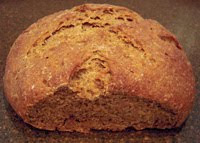 Overall, this recipe was enlightening but frustrating. First, for this bread, Reinhart gives a recipe that makes two loaves instead of the usual one—something I initially overlooked. My intention had been to make three half-loaves but I ended up making three full loaves, a lot more bread that I wanted or can use.
Overall, this recipe was enlightening but frustrating. First, for this bread, Reinhart gives a recipe that makes two loaves instead of the usual one—something I initially overlooked. My intention had been to make three half-loaves but I ended up making three full loaves, a lot more bread that I wanted or can use. Also, along the way, I discovered source of another problem I was having. I typically use a fairly wet starter when making sourdough breads—a starter that is equal parts flour and water. This makes feeding the starter particularly easy. I should have remembered that Reinhart's recipes call for a stiffer starter (or checked), but I didn't.. (I read the introductory material in the book quite some time ago. Obviously, I need to reread it.) It is fairly easy to correct for a wet started, but this isn't something I have been doing. And since these recipes use a hefty amount of starter, I've been adding more water/less flour than the recipe called for. Hence the sticky dough. Mea culpa.
My goal in making three (half) loaves was to experiment with the kneading to see what really works best and to see if that was the cause of the problem with the last loaf. There is some inconsistencies among bakers as to the optimal kneading of rye breads. It is certainly the case that rye breads can be over kneaded. But, there is also the question whether you want to go until the dough passes the window-pane test or stop just short of that point. The rational of stopping a bit short is that the gluten will continue to develop during fermentation and proofing and with additional handling.
 With this in mind, I set out to make three otherwise identical loaves but with different degrees of kneading. I began by mixing one large batch of dough, one and a half times the original recipe up to the point of kneading. I then divided the dough into three equal portions and kneaded by hand the first portion three minutes, the second portion five minutes and the last portion seven minutes. The first loaf was way short of passing the window-pane test, the second loaf just short of passing, and the third loaf clearly passed the test.
With this in mind, I set out to make three otherwise identical loaves but with different degrees of kneading. I began by mixing one large batch of dough, one and a half times the original recipe up to the point of kneading. I then divided the dough into three equal portions and kneaded by hand the first portion three minutes, the second portion five minutes and the last portion seven minutes. The first loaf was way short of passing the window-pane test, the second loaf just short of passing, and the third loaf clearly passed the test. The loaves are shown left to right in the first picture and from bottom to top in the second picture. The under-kneaded loaf clearly fell short of an optimal loaf. It was the slackest loaf, had a dense crumb, and showed the crumbly crust around the scoring seen in my previous loaf. The loaf that was just short of passing the window-pane test proved to be the best loaf by a small margin. It had the most pleasant crumb and the best shape.
As an aside, where Reinhart says you can use either rye or whole wheat flour, I used an equal mixture of the two. In Reinhart's Baker's Formula, he reports that the bread is 24% rye and 76% whole wheat. In doing so, he is clearly assuming that the baker is using all whole wheat when faced with a choice. The percentages would be reversed (roughly) if the baker used all rye instead. In using an equal mixture, I made a loaf that was about 50% rye.
As for overall taste, this recipe is okay. The experiment will help me judge my loaves and improve. But this isn't a recipe I'm likely to make anything soon. And I certainly wouldn't make two full loaves, let alone three.

